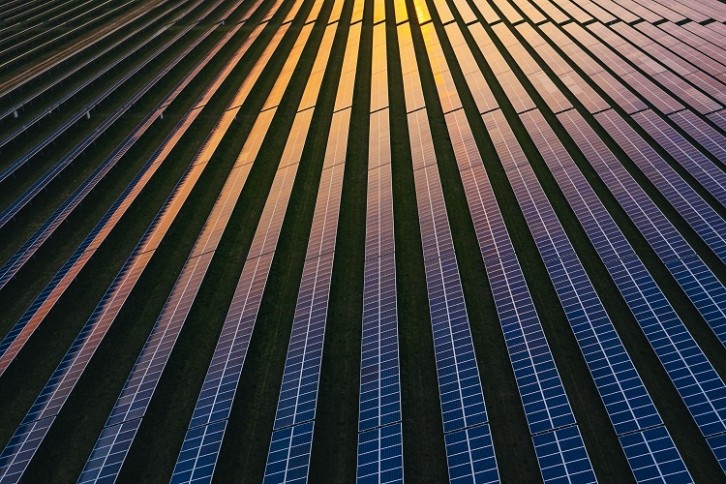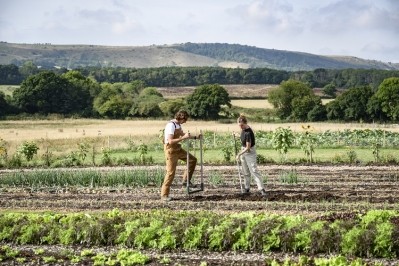‘Solar electricity generation does indeed contribute towards keeping farming profitable’: Solar panels on farmland in a cost-of-living crisis

As farmers, much like everyone else, struggle with the cost of living, having farmland leased out by energy companies can often seem like a good option.
On the one hand, while not necessarily impacting actual food production, the decision to lease land for solar panels is often difficult for farmers. “Farmers have an emotional attachment to their land,” Lucy Bullock-Sieger, VP for strategy at US renewables company Lightstar Renewables, told FoodNavigator.
On the other hand, the transactions often provide farmers with a reliable stream of income in a time when costs are high.
The fat of the land
Using agricultural land for solar farms does not necessarily need to come at the expense of food production. In some cases, it can even improve it.
Land can be used simultaneously for solar panels and farmland, a combination which is called agrivoltaics. While the process forces farmland and solar panels to share light, this does not necessarily harm yields and can even, according to a 2019 study in Nature Sustainability, improve them.
“Studies in the US and Europe have shown that agrivoltaics projects provide crops under the array protection from early and late frosts, reduce the amount of water required for irrigation, and improve soil health over time, resulting in increased food yields,” Bullock-Sieger told us.
Additionally, according to Sarah Webb, Business Development Director for UK-based renewable energy company Anesco, using farmland for solar panels can also increase biodiversity. “We always strive to enhance the biodiversity of any land we develop,” she told us. “For example, we will create habitats for the most at-risk wildlife and bird species. One site we recently developed saw a 100% improvement.”
However, while there are proven benefits to food production and biodiversity, one of the key drivers for farmers to lease their land is financial. According to Webb, the cost-of-living crisis is a significant factor in the uptick of leasing.
“While every project is different and the reason behind leasing the land will vary for farmer to farmer, we have certainly seen an increase in enquiries from those who are keen to generate additional income due to financial challenges,” Webb told FoodNavigator.
“We have also worked with farmers who want to secure long-term guaranteed income for future generations. Or they may be nearing retirement age and are looking at alternative opportunities for their land, with farming becoming physically more challenging.”
“Solar electricity generation does indeed contribute towards keeping farming profitable by offering income diversification to farmers,” Peter Hess, External Affairs Manager for EDF Renewables, the renewables arm of UK-based EDF Energy, told us. “This is certainly a major benefit to farmers who also tend to be rather passionate about climate change and its effects on food security.”
However, the energy produced, at least in the case of Anesco and EDF, does not go directly to the farmers. “The projects that we design and build at Anesco are large scale solar farms and the energy produced by them is fed into the national grid,” Webb told us.
“Whilst the energy produced does not go directly to a farmer’s buildings, it adds to the UK’s electricity network and importantly supports the country’s move to green energy and the target of net zero carbon emissions.”
“The solar farms that we develop are of a size that they are connected directly to the transmission network rather than into the farm,” EDF’s Hess added. “As more and more renewables are connected, we are becoming less reliant on fossil fuels and any energy intensive processes are slowly being decarbonised as a result.”
The process of leasing
Farmland needs to be assessed by the energy company before it can be leased to be used by solar farms. First, at least according to the leasing process undertaken by Anesco, the farmer must provide a plan to indicate which land they are considering. The energy company will do an in-house assessment of the land, ascertaining whether it lies in an area of high flood risk or a conservation area.
“If the land is deemed suitable,” Webb told us, “we will establish the grid capacity that is potentially available within the area, to see if the scheme could be connected and at a viable price. The timescale for getting a grid connection will also give an indication of the potential timeframe for the project.”
At this point the agreement between the farmer and the energy company will be made, and after the solar panels are connected into the grid, the farmer and energy company will enter into an ‘option agreement,’ giving the energy company use of the land for an agreed amount of time, which ‘typically tends to be a period of 40 years’ according to Webb.





